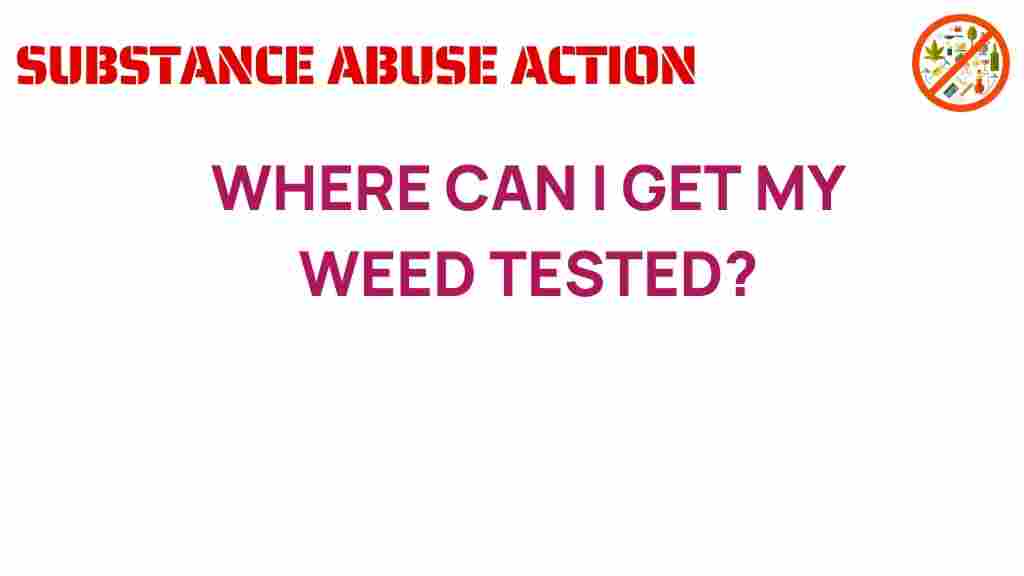Unraveling the Mystery: Where Can I Get My Weed Tested?
The growing acceptance and legalization of cannabis have led to an increased demand for weed testing. As consumers become more educated about cannabis quality, they often seek reliable methods to ensure the safety and potency of their products. This article aims to provide you with comprehensive information on where to get your weed tested, the importance of lab testing, and how it can affect your cannabis experience.
Understanding Weed Testing
Weed testing refers to the process of analyzing cannabis products to determine their chemical composition, including the levels of cannabinoids like THC and CBD, as well as identifying contaminants. This testing is essential for several reasons:
- Ensures consumer safety by detecting harmful substances.
- Helps consumers understand potency and effects.
- Assures compliance with local regulations.
- Informs consumers about the quality of the product.
Why is Lab Testing Important?
Lab testing is crucial for assessing the quality and safety of cannabis products. Here are some key aspects:
- THC Levels: Knowing the THC content helps users gauge the potency and expected effects of their cannabis.
- Contaminant Detection: Testing can uncover pesticides, heavy metals, and mold, which can be harmful when ingested.
- Consistency: Regular testing can ensure that products maintain a consistent quality over time.
How to Get Your Weed Tested
Now that you understand the importance of weed testing, let’s explore how to get your cannabis analyzed.
Step 1: Identify Your Testing Needs
Before you seek out a testing facility, determine what you want to know. Are you primarily interested in:
- Potency Testing: Understanding THC and CBD levels.
- Safety Testing: Checking for contaminants.
- Full Spectrum Analysis: Comprehensive testing for cannabinoids and terpenes.
Step 2: Locate a Certified Lab
Finding a reputable lab is crucial for accurate results. Look for the following:
- Certification: Ensure the lab is certified by relevant authorities (e.g., ISO/IEC 17025).
- Experience: Choose a lab with experience in marijuana analysis.
- Reputation: Read reviews and ask for recommendations from other cannabis users.
For a list of certified labs, you can refer to your local cannabis regulatory agency’s website or search for an accredited lab in your area.
Step 3: Prepare Your Sample
When preparing your sample for testing, follow these guidelines:
- Freshness: Use a fresh sample to ensure accurate results.
- Quantity: Most labs require a specific amount (usually around 1-2 grams) for testing.
- Packaging: Seal your sample in a clean, airtight container.
Step 4: Submit Your Sample
Once your sample is ready, visit the lab to submit it. Many labs offer an online submission process as well:
- In-Person Submission: Bring your sample to the lab and fill out any necessary forms.
- Online Submission: If the lab allows, you can ship your sample after completing the online submission form.
Step 5: Receive Your Results
After a few days to a couple of weeks (depending on the lab), you will receive your testing results. Here’s what to look for:
- Potency Report: This will include the levels of THC, CBD, and other cannabinoids.
- Contaminant Report: Check for any harmful substances detected in your sample.
- Compliance Report: Ensure the product meets local regulations.
Troubleshooting Common Issues
Sometimes, issues may arise during the testing process. Here are some common troubleshooting tips:
Sample Rejection
If your sample is rejected, it may be due to:
- Insufficient quantity.
- Contamination during handling.
- Improper labeling.
Always double-check the lab’s submission guidelines before sending in your sample.
Delayed Results
Delays can happen due to:
- High volume of submissions at the lab.
- Technical issues with testing equipment.
If you experience a delay, don’t hesitate to contact the lab for updates.
Understanding Your Results
Test results can sometimes be confusing. Here are some tips for interpreting them:
- Look for a summary section that highlights key findings.
- Compare your THC levels to the average potency of similar products.
- If contaminants are present, check the levels against safety standards.
Conclusion
In conclusion, weed testing is an essential process for anyone consuming cannabis. By understanding where and how to get your cannabis tested, you can ensure a safer and more enjoyable experience. Remember to prioritize safety, choose a certified lab, and stay informed about the regulations in your area. For more resources on cannabis safety and regulations, you can visit this helpful guide. If you have additional questions about cannabis quality or lab testing, don’t hesitate to reach out to professionals in the field.
This article is in the category Health and created by SubstanceAbuseAction Team
